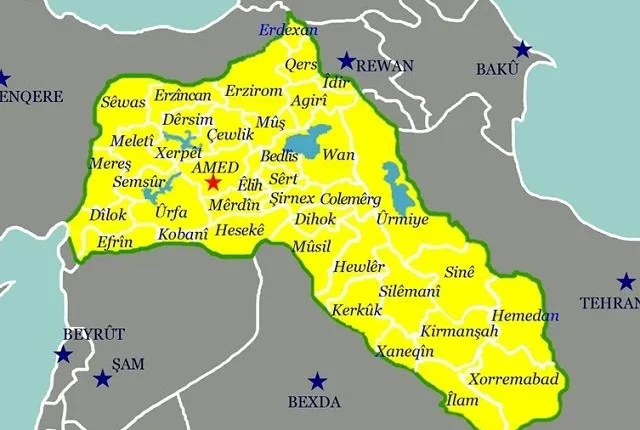The issue of the ethnic origins of national leaders has drawn considerable attention since the establishment of Iraq under a colonial framework that placed Kurds and Arabs within a political entity that quickly revealed its fragile structure. This was particularly evident in the use of ethnic origin as a weapon to undermine opponents and obstruct their political advancement.
The resurgence of this issue and the examination of political actors’ intentions became prominent with the rise of General Bakr Sidqi in Iraq and his ascent to power, as well as in the case of the Syrian coup leader Husni al-Zaim, who was accused of attempting to create a “Kurdish military republic.” Both of these Kurdish figures were among the first to introduce military coups to the region, a practice that continued until the last two Baathist coups in Syria and Iraq. They have frequently been characterized as having conspiratorial implications against the Arab identity of both countries, with the coups appearing as a blend of personal ambition and fascination with Atatürk’s model of coup and governance—especially the dictatorial style aimed at enforcing political and social modernization from above.
Bakr Sidqi was the pioneer of the first coup witnessed in an Arab capital in 1936, followed by the coup of the “Four Colonels” (the “Golden Square”) in 1941. These two coups paved the way for the emergence of distinct phenomena within the officer corps. According to Hanna Batatu in his work, “Iraq: Social Classes and Revolutionary Movements,” the distinction between “Iraqis and Arab nationalists” emerged, later manifesting as Iraqi nationalism and the “eternal Iraqi republic” articulated by Abdel Karim Qassim, in contrast to the nationalists, Baathists, and the “eternal Arab nation.”
Sidqi, born to Kurdish parents in the town of Askar near Kirkuk, succeeded in overthrowing Prime Minister Yasin al-Hashimi, a prominent Arab nationalist known for initiating Arabization policies in Kirkuk. Sidqi’s rise coincided with the massacres that targeted Assyrians in Simel and elsewhere, and he quickly quelled tribal rebellions that erupted throughout Arab Iraq using aircraft.
Driven by Atatürk’s modernization movement and strongly influenced by the rise of Nazism, which appealed to sentiments opposing British colonialism, Sidqi became the subject of narratives intended to undermine his national integrity. Rumors circulated that he carried “a map of Greater Kurdistan” in his bag, one of the accusations indicating the importance of evaluating intentions and objectives based on ethnic origin when assuming power in a predominantly Arab country burdened by nationalistic anxieties and tales of external conspiracies. These accusations were further supported by Sidqi’s adoption of an “Iraq First” policy, allowing for a better understanding of the ethnic, sectarian, and religious diversity in the nation while curtailing the influence of active and discontented Arab nationalist groups, even as he garnered support from Kurdish national movements that distanced themselves from al-Hashimi’s excessive nationalism.
A critical element in the narrative of the coup’s success was King Ghazi bin Faisal’s approval of Sidqi’s maneuvers to oust Yasin al-Hashimi and his government. Testimonies from the king’s Kurdish aide and bodyguard, Fuad Aref, as well as Batatu’s accounts, reveal that Sidqi informed al-Hashimi himself on the day he marched to Baghdad that he had the king’s backing. Additionally, Sidqi garnered support from those who “had no privileges” in the kingdom, rallying around the newspaper “Al-Ahali” and uniting in support of him.
Among various reasons, the roots of the coup were not based on a “Kurdish conspiracy,” as was widely rumored at the time, despite the involvement of Kurdish officers; the immediate cause was al-Hashimi’s tyranny. Mohammad Salih Sulayman sarcastically remarked that the call should change from “Long live the King” to “Long live the self,” referring to the concentration of power in al-Hashimi’s hands. Sulayman, a friend of Sidqi, became Prime Minister following the coup and expressed his anger toward al-Hashimi for not granting him a ministerial post in his previous government.
The emphasis on Sidqi’s Kurdish origins was amplified due to his friendship with the German ambassador to Iraq, Fritz Grobba, who claimed that Sidqi was planning to establish a “Greater Kurdistan” that would include Iraqi, Turkish, and Iranian territories, framing it as a powerful state capable of maintaining its independence. Grobba’s statements were troubling as he also claimed that Sidqi requested a German Chief of Staff to protect Kurdistan in the event of a British occupation of Baghdad.
Subsequently, Colonel Heinz, a retired officer, devised a plan to protect northeastern Iraq (Kurdistan), posing as a geologist while surveying the borders from Rawanduz to Khanqin and traveling to Iranian Kurdistan to develop military strategies for fortifications and artillery placements. He provided copies of these maps, written in German and translated into English, to Sidqi and Grobba, which later led to speculation after Sidqi’s assassination at the Mosul air base in 1937 while en route to Turkey that Shakir al-Wadi, the future Iraqi Minister of Defense, had obtained the alleged map. This reinforced accusations of Sidqi as being racist and anti-Arab nationalist while being involved in Kurdish nationalist causes. Ironically, Kurdish officers such as Muhammad Khurshid al-Dalawi and Abdul Aziz Malaki, who were members of the Arab-majority “Fire Stars” group, participated in his assassination.
Debate regarding Sidqi persisted, with some denying his Kurdish nationalism while others labeled him a Kurdish conspirator, despite his contribution to purging the army of certain Kurdish elements and signing the Saadabad Pact, which strengthened relations among Turkey, Iraq, and Iran. He had no affiliations with Kurdish organizations or movements and did not support the revolts led by Sheikh Mahmoud al-Hafid Barzanji (1919-1924) or the first Barzani revolt (1931). Conversely, some analyses contend that Sidqi, who did not support his compatriots, also rejected Prime Minister Ali Joudat’s request to suppress “Kurdish insurgencies” in 1935.
The story of the Greater Kurdistan map remains one of the enigmas in contemporary Iraqi history, linked to issues shaped by ideological biases that find comfort in conspiracy theories. Furthermore, most historians have found no evidence of collaboration between Sidqi and the active Kurdish national movement of the time, nor have they identified this map or explained why a “nationalist” would carry such a controversial map while headed to Turkey for military maneuvers.




Comments are closed.